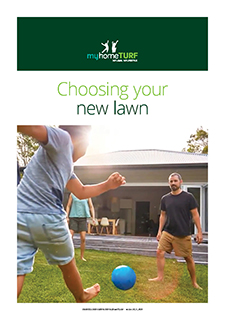Broadleaf Carpetgrass – Is It the Right Grass for You?
This perennial warm-season grass is an appealing choice for homeowners in tropical parts of Australia – especially northern Queensland. With excellent shade but poor drought ...

From identifying the features you need, to understanding the best turf variety for your climate, this guide covers it all…
After reading this guide from head to toe you will be more than qualified to choose a turf variety for your new lawn.
Some of the main benefits of laying turf in your home:
Lawns are a lot more than just grass but an interaction between the natural environment and the constructed urban and suburban space.
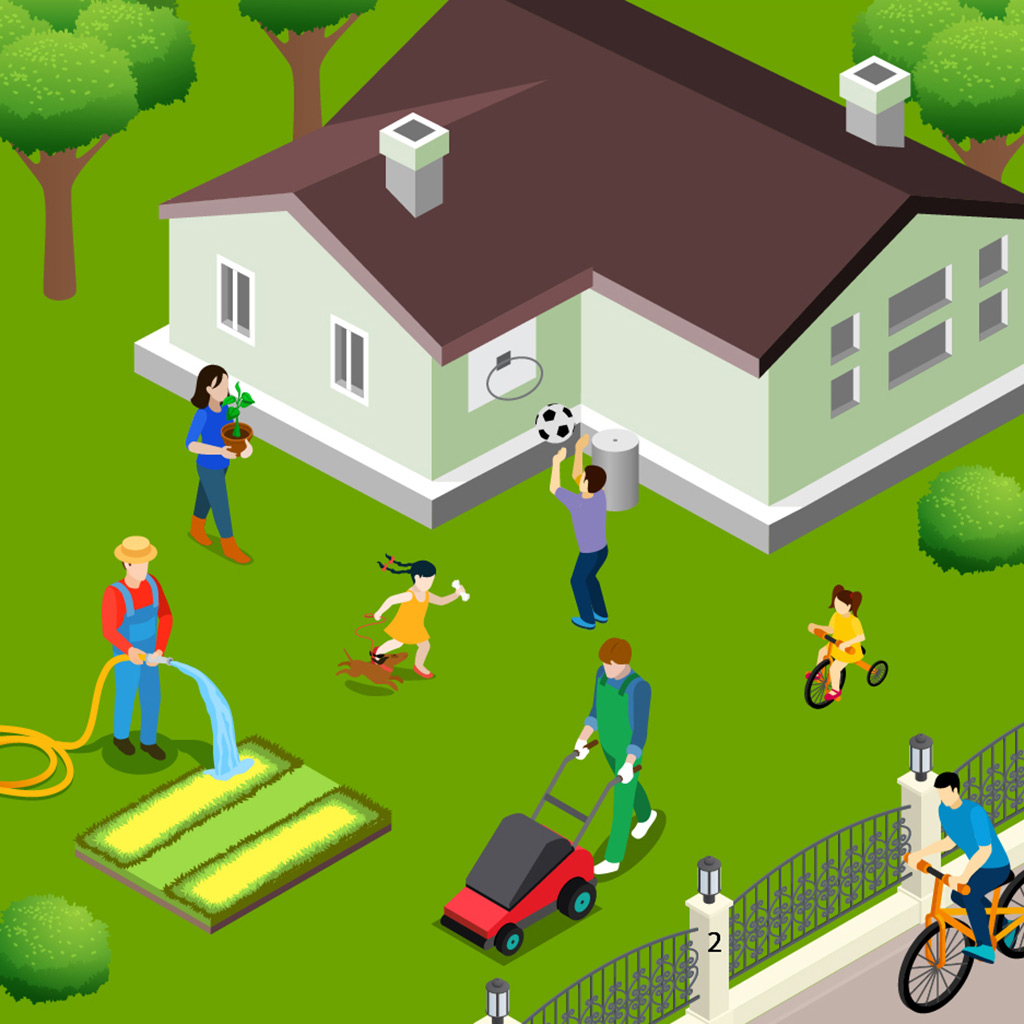 Today’s lawns are also about making the consumer happy, and that can be done efficiently, cost-effectively with contact-free delivery.
Today’s lawns are also about making the consumer happy, and that can be done efficiently, cost-effectively with contact-free delivery.
The natural green space created by your lawn promotes physical exercise, improves mental health, for your children and fur babies it creates a cooling effect around your home, acts as a natural water purifier and can also act as erosion control.
There are a variety of reasons you might want to lay a new lawn. Now let’s discover the top turf types on the market you can choose from…
The first step to buying turf is understanding what turf variety you need.
Homeowners have a vast array of turf varieties available to choose from that suit many different conditions and lifestyle circumstances.
Some of the most popular turf types include:

Buffalo lawns are one of the most common grasses on the market that look luscious, soft, green and are hard wearing as well as offer great shade tolerance.
As a warm-season grass, they are known for being distinctly green in colour, self-repairing and less invasive to garden edging compared to Couch or Kikuyu grasses.
Most Buffalo grasses are also low in maintenance and require minimum water, mowing and fertiliser.
As Buffalo grasses have a deep-rooted system, they can also be efficient water users – staying green longer in dry conditions.
Popular Buffalo turf varieties include Prestige Buffalo, Sapphire Buffalo & Palmetto Soft Leaf Buffalo.
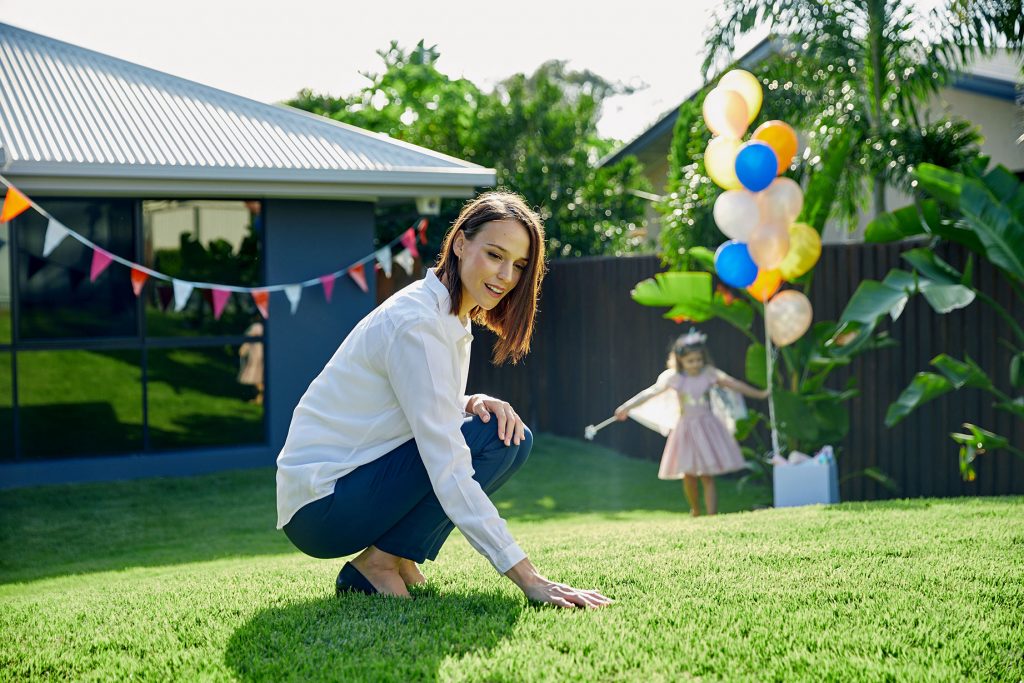
Zoysia grasses, once established, are known for being low maintenance (less water, fertiliser, and mowing), as well as drought and wear tolerant.
Thanks to Zoysia’s deep-rooted, underground runner system they have the strength to endure heat, humidity, and sub-zero temperatures.
Zoysia grasses, while being tough and robust, also have a lush carpet-like dark green appearance.
Zoysia turf does best in full sun but can handle moderate shade.
Popular Zoysia turf varieties include Augusta, Empire and Nara Native Zoysia.
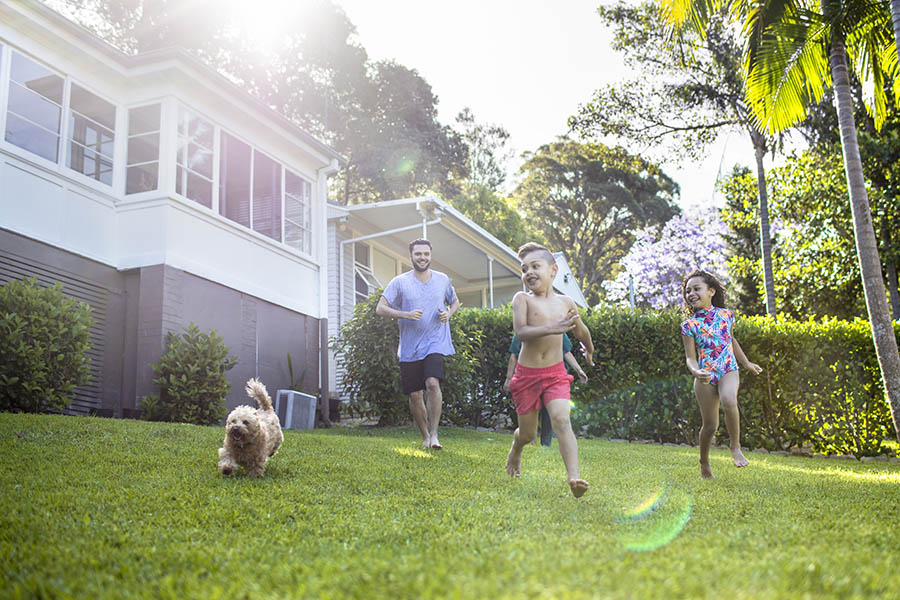
Kikuyu grass is a true stalwart that is known for having a think mat layer and rapid growth which contributes to its quick recovery rate from high traffic.
Kikuyu turf provides a great option for lawns that endure lots of sports, play or pet activity.
These grasses also tolerate a wide range of soil conditions and are very drought tolerant thanks to Kikuyu turf’s prostrate runners and excellent growth rate.
Many homeowners also prefer Kikuyu because of its dense, bright green soft leaf which stays green longer in winter.
Most Kikuyu grasses do spread easily onto paths and invade garden areas so must be regularly maintained.
Kenda Kikuyu, however, is a sterile variety bred to not spread or produce seed head so is less invasive in garden areas and is good for allergy sufferers.
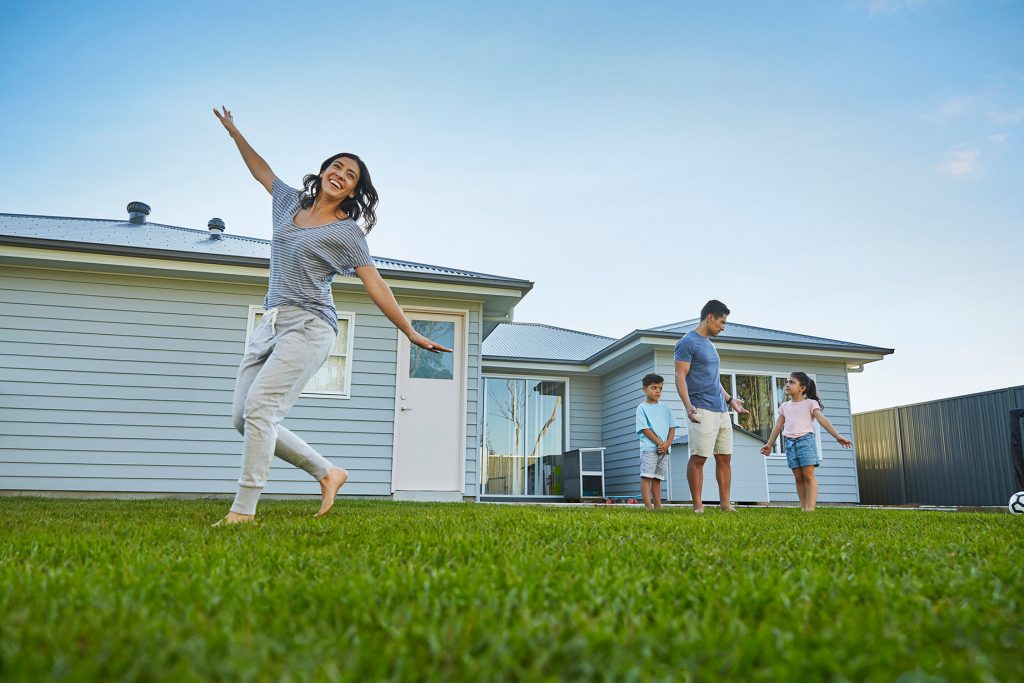
Couch grass is one of the most popular Australian lawns due to its hardiness and drought tolerance.
Couch lawns are popular for sporting fields as they are soft to touch and underfoot but have robust roots to cope with wear and tear.
Homeowners prefer Couch lawns due to their natural dark green colour that is maintained during cooler months and even in poorer quality soils.
With a fine leaf blade, Couch turf is an ideal yard lawn for kids and pets and copes with the rough and tumble.
Couch breeds such as OZTUFF Couch, IronCutter®, and Stadium Sports Couch have a dual purpose of being ideal for homeowners as a hard-wearing, good looking lawn or for sporting fields.
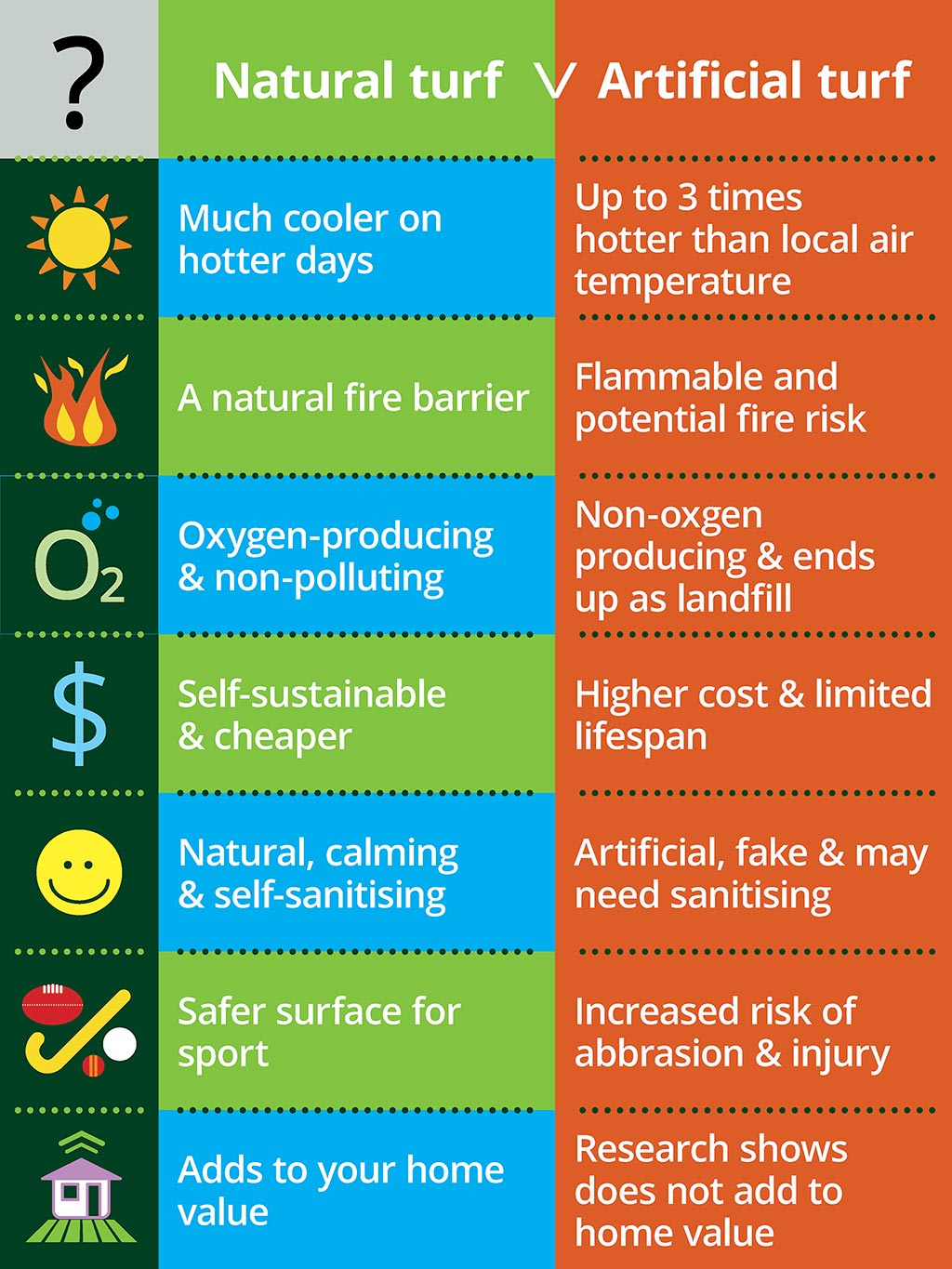 It is hard to deny that a natural green lawn looks, feels and is good.
It is hard to deny that a natural green lawn looks, feels and is good.
However, in today’s fast-paced society, artificial turf can be considered the easy, low maintenance alternative, ultimately saving water, time and money.
Even with advances in technology and improved materials, artificial turf might look like an attractive option but you might be surprised to learn that it is actually more expensive to our environment, your health, your hip pocket and your property value than you think.
In addition, some artificial grass manufacturers recommend regularly applying water to counteract the high temperatures reached on hot days by artificial turf surfaces.
Did you know that artificial turf can be up to 30°C hotter than natural turf on a hot summers’ day?
If you love the feeling of natural grass between your toes while playing a game of backyard cricket or just want to come home to a pristine-looking lawn – natural turf is likely the choice for you.
So, if you are looking for natural turf, the next step is to identify the features you need.
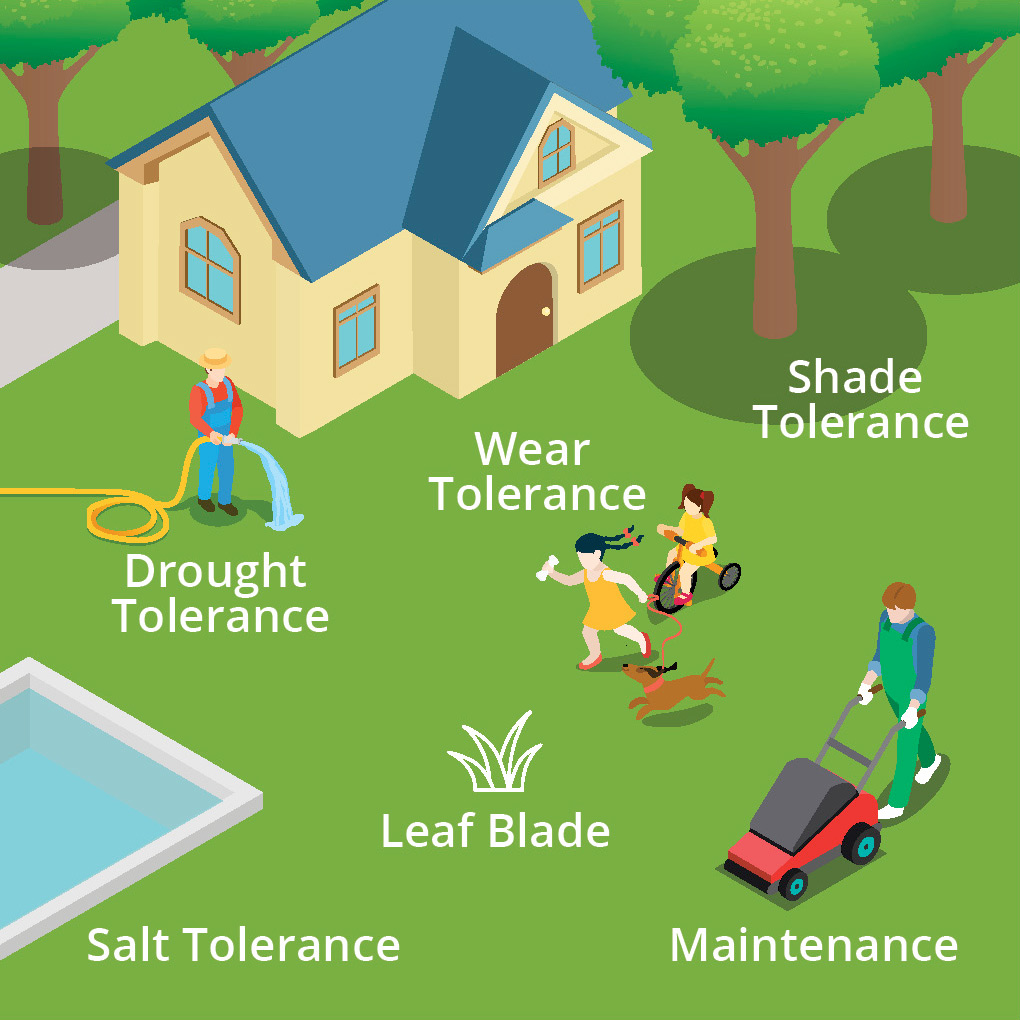 When selecting a new lawn, it is important to consider climate size, orientation and how you want to use your lawn, and, simply, understand the benefits of why you are choosing turf.
When selecting a new lawn, it is important to consider climate size, orientation and how you want to use your lawn, and, simply, understand the benefits of why you are choosing turf.
There really is no ‘one size fits all’ when it comes to choosing a turf variety.
Different turf varieties have different characteristics and features which make them more advantageous to certain homeowners.
That being said, there are 6 top features we recommend most homeowners to consider and look out for when choosing a variety.
Below is a list of the 6 top turf features you need to consider when choosing a turf variety :
Shade coverage is always a big feature to take into consideration when selecting a lawn type for your yard.
Overhanging eaves, trees and bushes which over the years will cause shade must all be considered when selecting a lawn type for your yard.
Also, before selecting a lawn, evaluate the amount of sunlight your yard receives a day – shade-tolerant grasses need at least three to four hours of direct sunlight a day.
The best shade tolerant turf varieties that tolerate high shade coverage are Buffalos, with both Sapphire and Prestige Soft Leaf Buffalo tolerating up to 70% shade coverage throughout the day.
The next best shade tolerant lawns are Zoysia grasses followed closely by Couch and Kikuyu.
Drought tolerant turf types have features allowing them to stay alive and green for a longer period under extended dry conditions. Drought tolerant lawns also are ideally suited for regions that do suffer from heavy water restrictions during summer.
The key feature of drought-tolerant lawns is an efficient root system that actively buries into the soil seeking and storing water during periods of extended dry.
Many drought-tolerant grasses also go dormant during dry periods as a way of protecting themselves and are then able to recover quickly when water is next available.
Salt tolerant turf types are well suited to homeowners that either live on the coast, waterfront or have saline water conditions.
The beauty of salt-tolerant lawns is that they maintain their quality and green colour.
OZTUFF Couch is one of the highest salt-tolerant option on the market and has proven itself to handle saltwater levels 50% that of seawater.
Low maintenance turf types suit homeowners who lack the time to mow, fertilise and water their grass frequently but still want to enjoy the luxury of having their own lawn.
Generally, a low maintenance lawn has very slow-growing features and deep roots that seek out soil moisture.
Zoysia grasses are some of the best lawns for low maintenance due to their slow-growing and deep-rooted features and include Nara Native, Empire and Augusta. Buffalo grasses are also low maintenance options as they produce less thatch (low maintenance) and are less invasive to garden edging compared to Couch or Kikuyu.
If you want a wear tolerant lawn that will have high traffic, or wear and tear from either pets or kids be sure to select a deep-rooted grass that quickly recovers.
These sort of tough wearing lawns also have a dense cushion cover to protect them and produce a soft and lush feel to play on!
Kikuyu is a robust grass with a strong root system that grows vigorously and recovers from wear.
Couch turf also has high wear tolerance thanks to a moderate thatch layer that provides great wearability and recovery.
Buffalo grasses have deep roots as well as fast-growing stolons and runners that enable them to recover quickly from wear.
Zoysia turf recovers quickly from wear and tear thanks to fast initial growth across the ground and highly branched runners that provide rapid recovery.
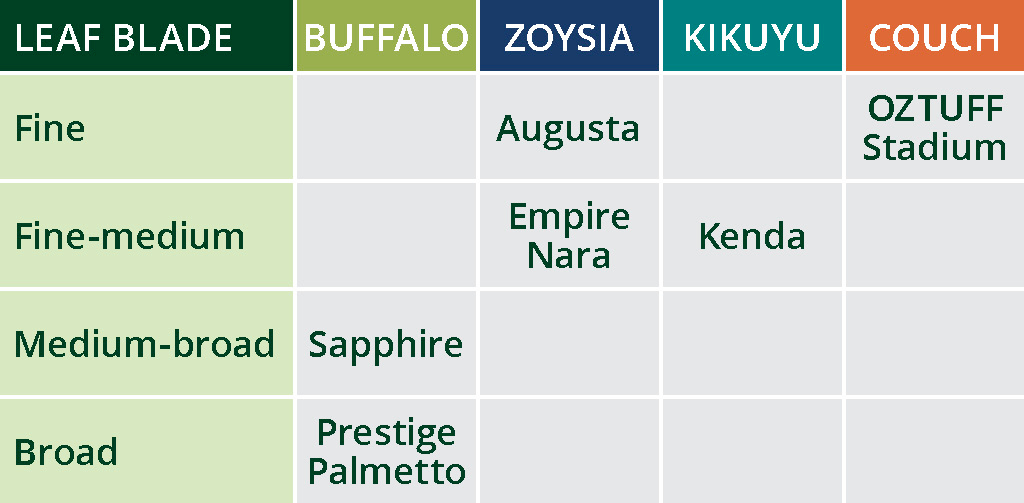
Many homeowners prefer a particular leaf blade that resonances from childhood or where they have seen turf in different areas such as sports fields or gardens.
Do you want a Broad leaf or prefer a finer looking grass?
Different grasses have different blade widths, folds, tip shapes and colours which offer different soft to touch underfoot and aesthetic appearances.
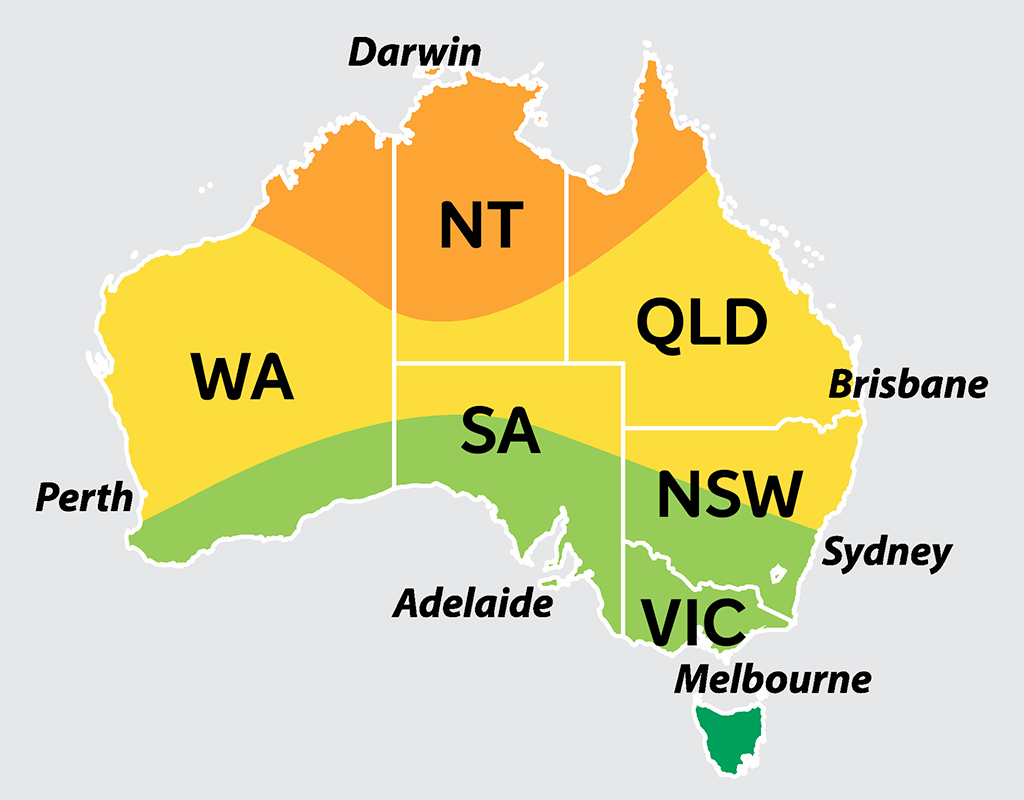 Before any turf variety is chosen it is important to understand your local climate and what conditions your lawn is going to be exposed to.
Before any turf variety is chosen it is important to understand your local climate and what conditions your lawn is going to be exposed to.
The local climate has a large impact on the growing conditions of your new lawn.
Different turf types boast a variety of different features, some of which are more advantageous to certain climates than others.
It is essential you choose a turf with the right features to suit your local climate.
So, which turf is best for your local climate?
When choosing a lawn for either south-east or northern Queensland it must-have features that cope with dry, sub-tropical to tropical conditions.
Most importantly when deciding which lawn will suit your QLD yard consider the amount of sun or shade your area receives and whether you want a drought-tolerant, robust variety of low maintenance.
With Sydney and NSW having climatic conditions varying from hot and humid to wet and cold there are a range of lawns suitable.
First consider how much water, sun and shade your area receives and based on these features choose the most appropriate grass – Buffalo, Zoysia, Couch or Kikuyu – all suitable turf types for Sydney and NSW.
Melbourne’s weather is different to both New South Wales and Queensland and predominantly has become quite wet in the spring and summer months with dryer, colder winters.
That said, the best grass varieties for Melbourne are Buffalo, Kikuyu, Couch and certain Zoysia grasses.
Remember to first consider how much water, sun and shade your area receives and based on these features choose the most appropriate lawn.
Adelaideans need lawns that won’t brown-off with the occasional frost, but can also cope with the scorching, bone-dry temperatures of January through to March.
Remember to first consider key lawn features such as how much water, sun and shade your area receives and then select the most appropriate grass.
Two ideal lawn types for Adelaide are Buffalo or Kikuyu grasses.
For Perth lawns, frosts are a rarity, with the very mild winters a trademark of Western Australia’s hot-summer Mediterranean climate with low humidity.
The best lawn options for Perth include Buffalo, Zoysia and Kikuyu as they suit the City’s harsh climate.
Before making any decisions about which lawn to grow in Perth first consider key characteristics such as how much water, sun and shade your area receives.
The cost of turf is based around the final quality product you as the customer expect to receive from our myhomeTURF suppliers.
All turf bred by myhomeTURF suppliers is of the highest standard with a commitment to deliver service and assistance when required.
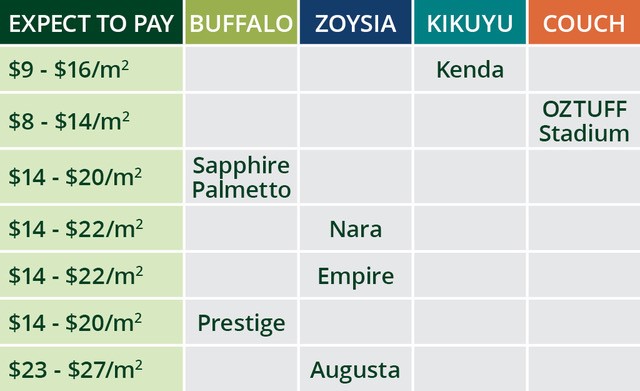
Many of our suppliers offer delivery and laying services. Find your local supplier with our online supplier locator tool.
Generally, expect a delivery fee of approximately $90-$150 (depending on location and offloading conditions) and a further $2/m2 for laying services (depending on site) *Exact costs can be confirmed when completing a myhomeTURF quote request.
To get more exact pricing info, get 3 quotes from your local suppliers today.
When purchasing a new lawn make sure you measure your area correctly.
myhomeTURF provides an easy calculating tool for all shaped yards.
Don’t forget that when measuring how much lawn you need always order an extra 10% just in case you have areas that require off-cuts.
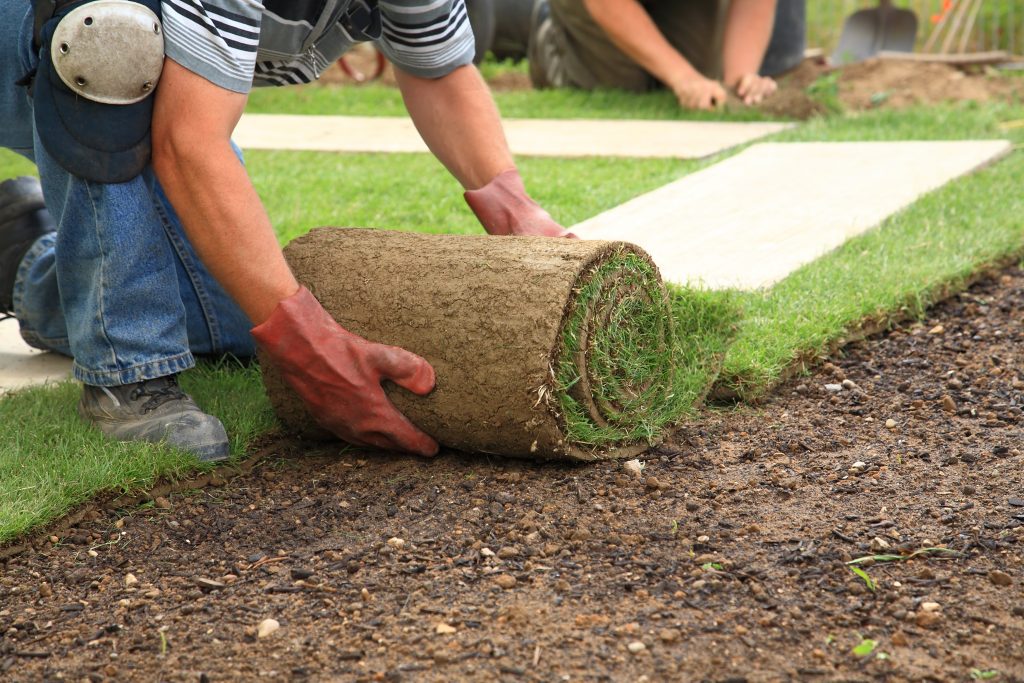
When it comes to turf, there’s no such thing as one size fits all solution.
myhomeTURF’s friendly suppliers can help you choose the right lawn for your home and lifestyle from our extensive network of turf suppliers – we can even arrange for three competitive quotes.
Find your local supplier with our online supplier locator tool. Or, get 3 quotes from local suppliers today.
Many of myhomeTURF suppliers & growers offer preparation, delivery and installation services.
Preparations costs depend on:
When choosing this option as part of a myhomeTURF quote, our suppliers will give an indicative price for this service.
An on-site inspection may then be arranged with your supplier to assess this indicative price. Please note that prices may vary depending on individual site circumstances.
If you decide to prepare and install your new lawn, remember good preparation leads to easy installation.
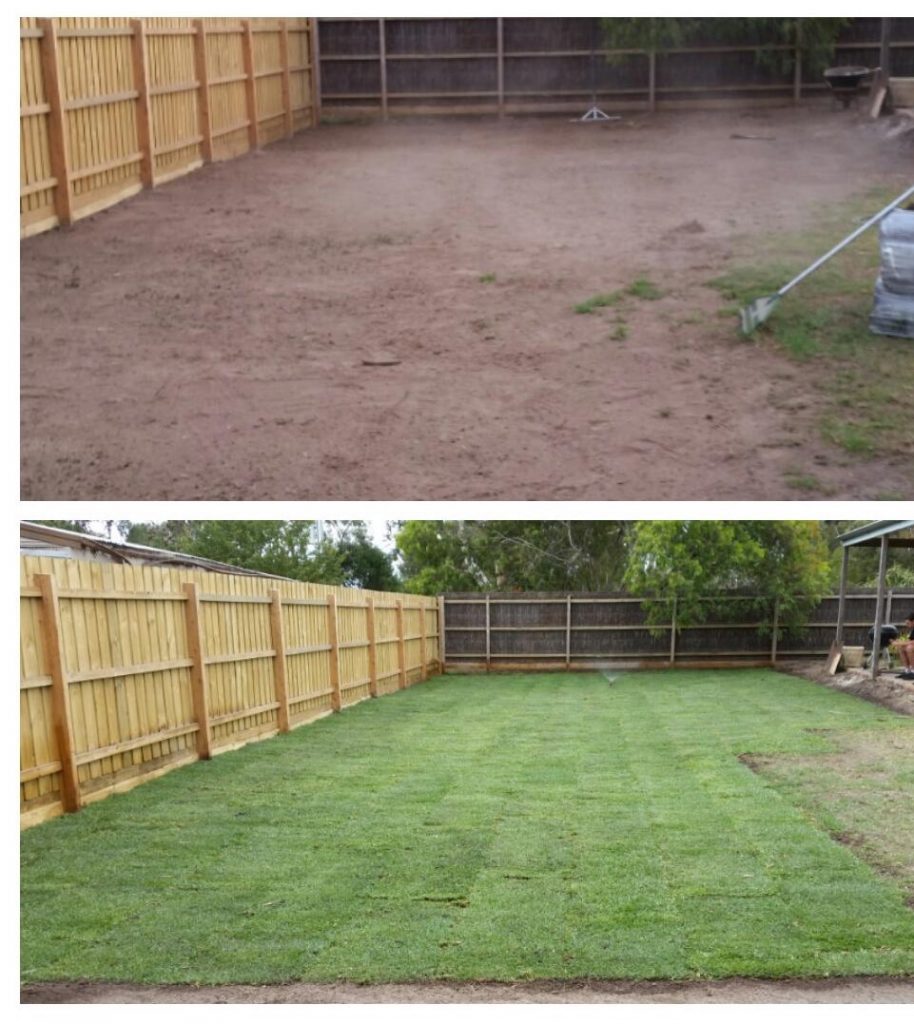
There are a few tools you need to make the process fun and easy.
The importance of preparing the site for your new lawn can never be overemphasised.
Many suppliers can prepare, deliver and lay your new turf – always ask when you are ordering your turf.
If you are preparing your yard yourself, first make sure you eliminate all existing weeds, grasses, and rock debris.
To avoid drainage issues, ensure the soil gradient slopes away from paths and buildings.
When preparing, be sure your soil type is suitable for your new lawn and ensure you have enough soil – at least 50mm to 100mm deep – before laying.
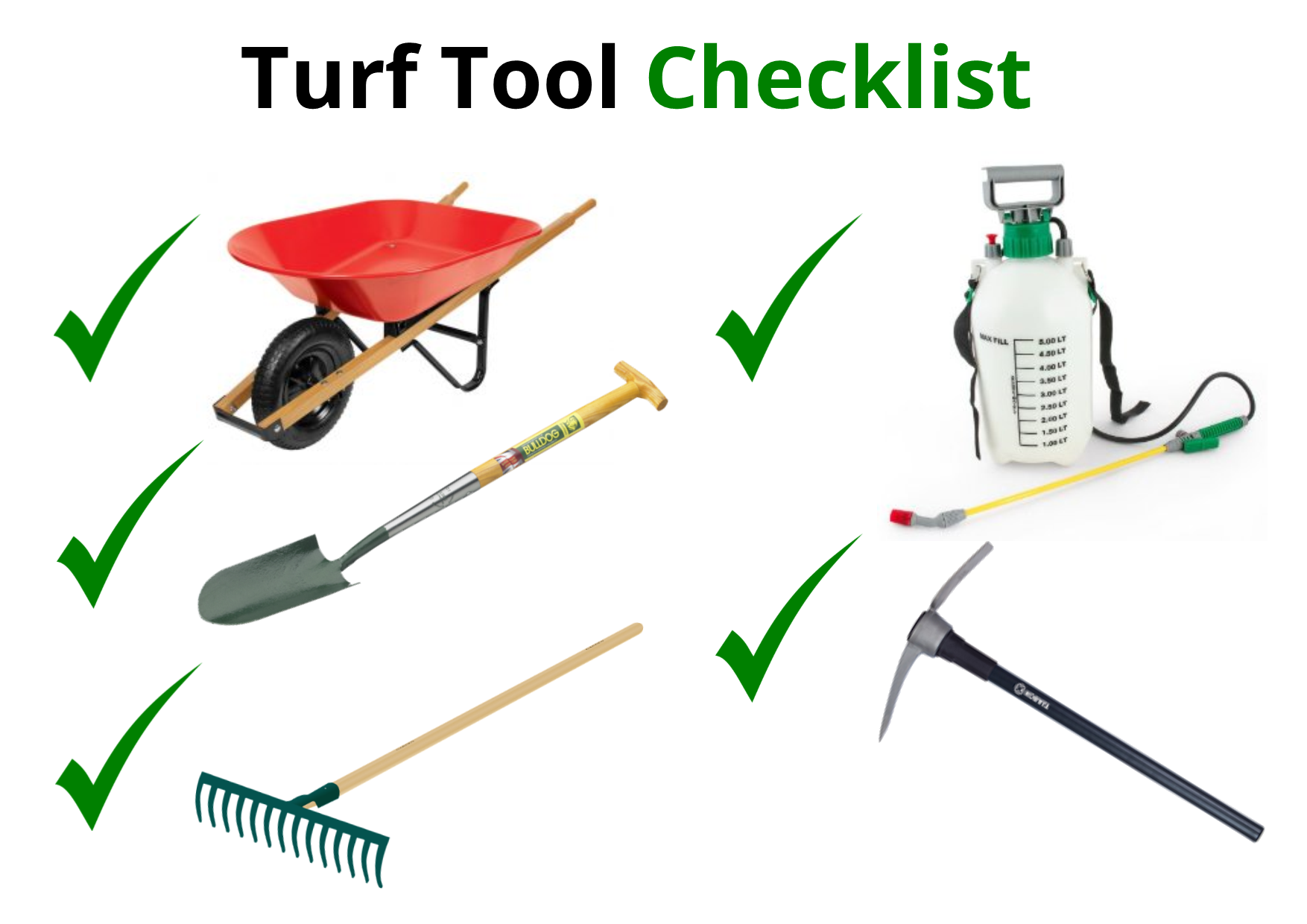
For more info, check out our preparing your lawn checklist.
Once your site is prepared for the new lawn – measure the entire section so you can then have your myhomeTURF supplier send you a quote.
Calculate your turf with our turf calculator if you are unsure.
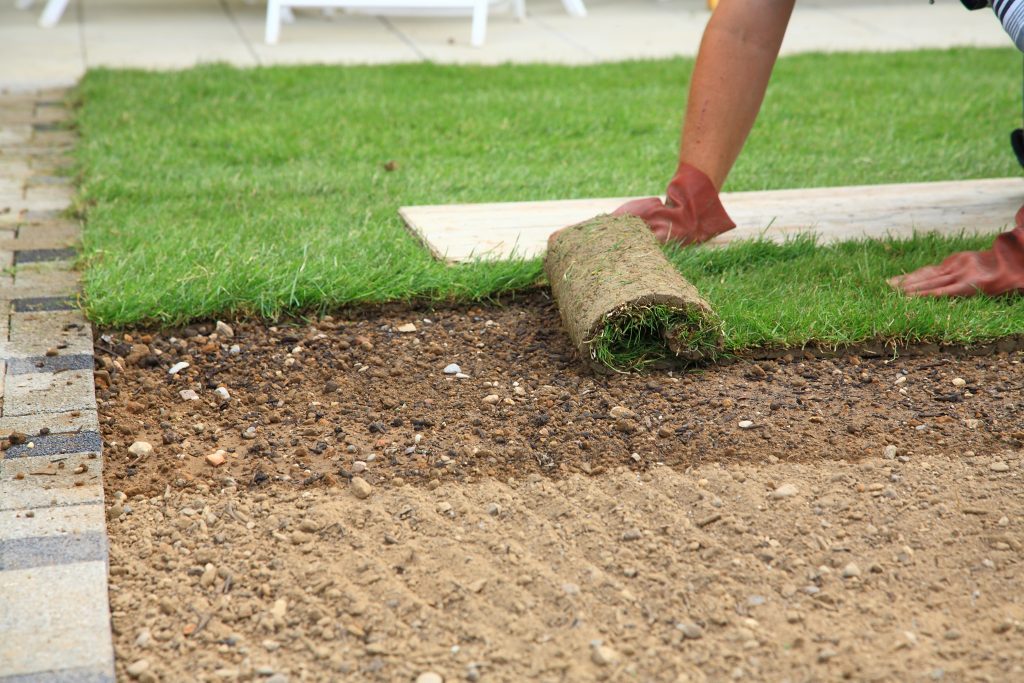
It is essential to lay your new lawn as soon as it arrives.
First lightly moisten the soil and then begin installing following the longest straight line such as a fence or paver.
Lay turf in a brick pattern (stagger joins) ensuring that each join is tightly bound together with no overlapping. To trim corners use a shovel or large sharp knife. Once your new lawn is completely laid, use a roller to ensure soil to turf contact.
For more info, check out our Step by step DIY guide for laying a new lawn
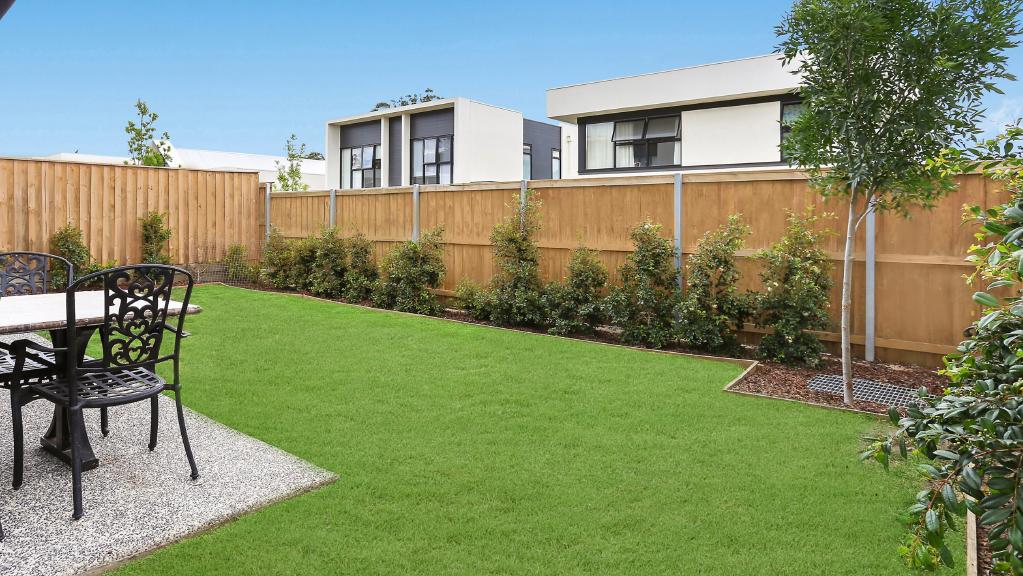
It is essential you undertake measures to keep your new lawn healthy.
The highest requirement for watering a new lawn is in the first week.
Watering your new lawn can then be reduced as the following week’s progress and the root system has established.
New lawns which are laid during the heat of summer require the most water – up to 4 times a day in the first week.
In warmer weather (high 20°s to early 30°s Celsius) new lawn needs to be watered less frequently – 3 times a day.
If laid in cooler weather the new lawn requires less water again – as low as 1 – 2 watering’s a day
During cool rainy weather, no extra watering of the new lawn is required in addition to what it is already being naturally received from the rain. To stick on the safe side, make sure to read our dos & don’t guide to watering a new lawn.
If you lay your new lawn in cooler conditions – just remember it will take a bit longer to establish – so be patient!
Sign up for our Newsletter to receive your free guide.
